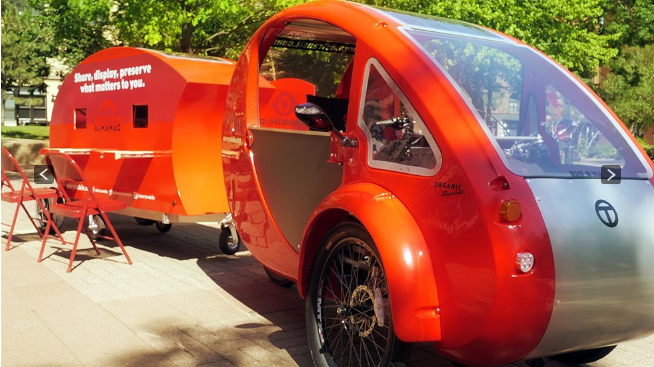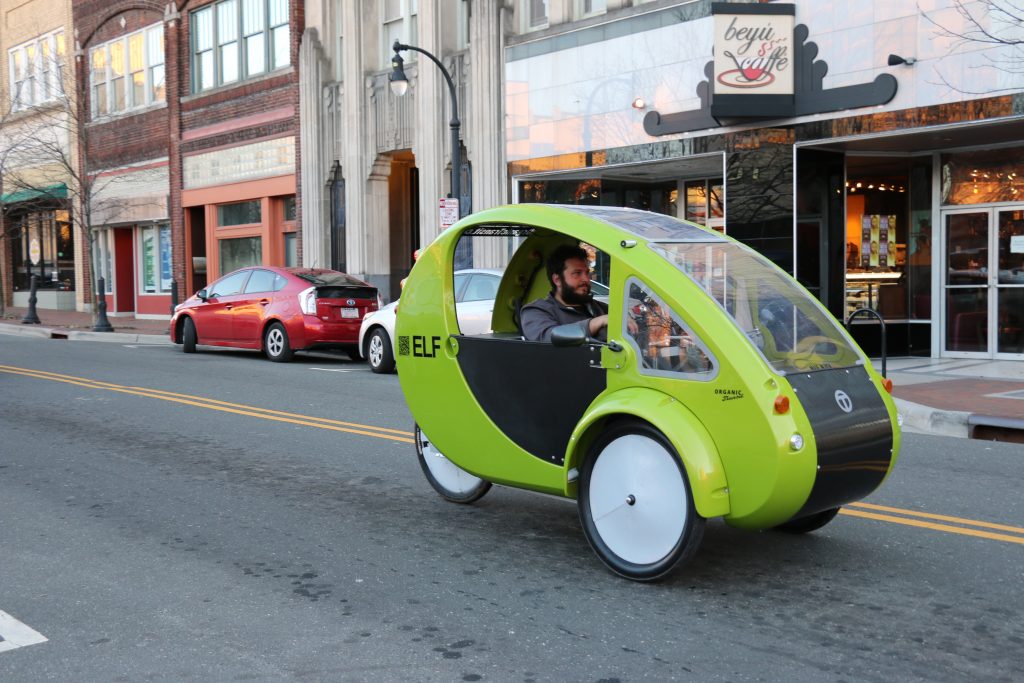At first glance, Organic Transit’s ELF solar/pedal hybrid vehicles may seem modest due to their petite size and slim shape. But a deeper look under the hood reveals something much more powerful and versatile. Capable of carrying up to 550 pounds of payload and boasting the equivalent of 1,800 miles per gallon of gas fuel efficiency, the ELF is a bold and unique entrant to the world of alternative vehicles, one that co-founder and CEO Rob Cotter believes can have a lasting impact on transportation in the world. I interviewed Rob to learn more about his experiences that led him to found Organic Transit, the ELF’s benefits, and the impact it’s had on its users.
How did Organic Transit originally get started?
Rob Cotter: Prior to the company I was consulting on New York City bikesharing, and it dawned on me when New York City was putting in 300 miles of new bike trails that there was definitely a market for a new vehicle like ours. That’s because as wonderful as bicycles are people have a hard time going up hills, they get sweaty, they have trouble riding in bad weather and carrying groceries or passengers, etc. We wanted to make something that gave them a boost up hills, protected them from the weather, was much safer and more stable so there was less chance of falling over, and had a more prominent position in traffic with turn signals and brake lights and things like that.
 In the Photo: An ELF vehicle in the snow. Photo Credit: Organic Transit.
In the Photo: An ELF vehicle in the snow. Photo Credit: Organic Transit.
In essence, you wanted something that merged the benefits of bikes and cars together, right?
RC: Absolutely. I have a background in these kind of vehicles, I used to be a vice president of the International Human Powered Vehicle Association in Southern California, and I had built a variety of vehicles back then and had been involved with many other vehicle projects like putting on the first solar car race in the US back in 1988. So I’ve always had a desire to do something like this because I realized that automobiles cannot go on like they are now. They’re grossly inefficient. Even on the electric vehicle side they’re just so inefficient, they weigh so many tons, they take up so much space, the list goes on. This also affects our own physical condition. The birth of the automobile and automotive culture has mostly stopped us from walking, and that’s really the root cause of the majority of our diseases.
Organic Transit’s ELF vehicles are pedal/solar hybrids, could you talk more about how they were developed?
RC: When I was the VP of the International Human Powered Vehicle Association back in 1981, the organization was created based on no rules of what a bicycle is. Conventional bicycle racing is very constrained on what they’re allowed to use, that’s why they all look exactly the same. In the IHPVA world, there are no rules other than it has to be human-powered. That’s about it. That meant no battery storage or solar panels or anything like that, but it allowed for extreme advances in aerodynamics, ergonomics, lightweight materials, and technology, and a lot of those innovations went right into streamlining race bikes as well as the old GM EV1 and EV2, the original electric cars from GM. That all came out of the human-powered vehicle movement.
So the technology has been around for a while to design better vehicles and better bicycles, it was just a matter of was there a market for it and were people willing to pay the price to have something very efficient, very clean, and very lean. With climate change and people moving into the cities at a significant rate, and with people’s increasing health conditions, it led to a market being there. That’s why we’re seeing a renaissance in cycling, but it took dips and turns that were unpredictable.
RELATED ARTICLES
![]()
VEEMO VELOMOBILE: AN INNOVATIVE ELECTRIC VEHICLE BY VELOMETRO
by Alessandro du Besse’
![]()
GETTING AROUND TOWN: AN INTERVIEW WITH GETAROUND
By Mohamad Akef
![]()
BOLTMOBILITY APPSCOOTER: MAKING ELECTRIC MOBILITY MORE ACCESSIBLE AND SAFER By Alessandro du Besse’
 In the Photo: An ELF trailer. Photo Credit: Organic Transit.
In the Photo: An ELF trailer. Photo Credit: Organic Transit.
What is Organic Transit’s customer base currently, and what do you want it to be in the long run?
RC: Currently our customers have a strong environmental bent, whether they’re using it for business, commuting, or running errands. They realize the significance that green transportation has. When all combined, ELFs have traveled 6 million miles in the last four years! Interestingly enough, over 10% of ELF’s riders have advanced degrees, about 30% of them earn pretty substantial income, and about 30% of them earn under $30,000 a year. It’s really both the enlightened and the people that can really see the economic benefits of not paying for insurance and registration and gas. These people are definitely using it.
What we’ve found is that this is not a toy, people aren’t buying it like a four-wheeler or a jet ski or something like that. They use it a lot. The average use is about 2,500 miles a year. One 80 year old gentleman in Virginia got his and two days later rode it back home to Arkansas. 1,600 miles, 80 years old. There aren’t a whole lot of bicycle-like vehicles that someone that age could do that with. This opens up many doors for people and shows its practicality. That’s the main emphasis here, it’s an environmental tool, it’s extremely practical, and it has a very wide stretch of current users.
We’ve been building them only in the US up until this point, which is a challenge in and of itself, but ultimately what we want our customers to resemble is everyone. In the beginning cell phones were very expensive and very limited in their use, and McKinsey did a study and told AT&T, “Don’t worry about cell phones, it’s just a niche market and it’s not going to have any traction.” Of course they were very expensive in the beginning, but now we’re all on them. I believe that once ELFs are spread throughout cities and are in a shared use basis, where you just wave your phone and hop in and go, our users will be anybody and everybody.
We’ll have a variety of vehicles too. There are the conventional ELFs that we have right now, where if you want to pedal you can, if you don’t want to pedal you don’t have to. But there are other versions too. We’ve sold a lot of vehicles to disabled folks, we have ELFs that are more catered to people’s physical requirements, and we have ELF-type vehicles that are better for urban deliveries and heavy loads. We change some gearings on some ELFs so they can be significantly better hill climbers, and we’re working with the University of Washington on an autonomous ELF.
I think as time goes on people are really going to appreciate they physical aspect of ELFs, because it means they didn’t have to go to the gym since they got their workout on their way to work or on their way shopping. It’s a huge advantage to be able to get into some kind of physical fitness while you’re running your errands. I love riding bikes, but sometimes you just want to be able to ride without climbing on a tiny seat, and sometimes you don’t want to ride in the rain or you need to carry a passenger, and that’s what an ELF allows you to do.
 In the Photo: An ELF driver and her ELF. Photo Credit: Organic Transit.
In the Photo: An ELF driver and her ELF. Photo Credit: Organic Transit.
What does the future of Organic Transit look like in your eyes?
RC: We created the company to address what we feel is the most pressing issue that we as a species and a planet face today, which is climate change. If Organic Transit is able to grow the way we’d like to see it, it will take a gigaton of carbon dioxide out of the atmosphere in the next 10-12 years. But there are other pressing issues that are similar and related in nature. The vehicle part is one, moving folks with disabilities is another. Getting people physically fit and making cities more livable are all really, really significant as well.
We keep incorporating more available technology, and we incorporate it into the lightest vehicle chassis that we can come up with. We can make them faster and more aerodynamic and do all sorts of things, but we want to do it in certain stages and steps that make sense for society. For instance, some people say, “oh, it’s so wide.” But it’s only four feet wide, and the reason we have it so wide is because bicycles and pedestrians interact with significant traffic, tons of steel rolling down the road. When you ride a bike and get hit by a car, you’re going to get hurt. You’re going to hit the ground and God knows what happens from that point on, but you’re going to get hurt. We’ve had ELFs hit by cars at 40-50 MPH, and people are hardly bruised. Aluminum and composite crumple zones provide a level of safety unavailable on a bicycle.
Part of our company also includes basic things like using LED lighting, using recycled and recyclable materials, using old buildings instead of building new ones, putting in rain gardens, etc. We just do everything as clean and efficient as possible, and ultimately we would like to be addressing things like food distribution, water purification, and energy backup systems. All of these things could be looked at the way Organic Transit looked at conventional automobiles. We think that that dramatic kind of shift has to happen for people and the planet to really get healthy. Many people out there want to participate, and many people are educated or intuitively know what the right thing to do is. Ultimately, we see Organic Transit as a new alternative to the giant automotive companies and culture.



 In the Photo: An ELF vehicle in the snow. Photo Credit:
In the Photo: An ELF vehicle in the snow. Photo Credit:  In the Photo: An ELF driver and her ELF. Photo Credit:
In the Photo: An ELF driver and her ELF. Photo Credit: 






